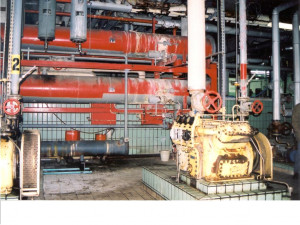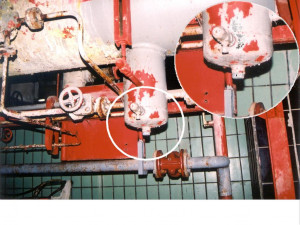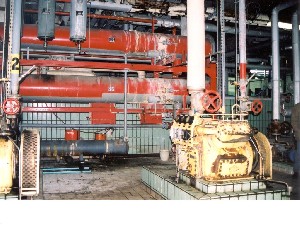In a cheese factory, ammonia (NH3) leaked during the morning in a 4,000 m² (50 x 20 x 4 m) building housing the ice water production unit operating at 0.4 Mfg/hour, with 3 independent refrigeration circuits containing 1 tonne of NH3 each connected to an ice water tank; water was being cooled in a circuit open to contact with NH3 pipes at -10 °C. Each circuit comprised a compressor, multi-tubular condenser, buffer bottles and the ice tank serving as an evaporator (grating).
A subcontracted welder was working on the cooling circuit of a condenser whose bolted overlap flange on the shell end cap had eroded. Water had been leaking for 2 days, and the operator decided to repair the oxidized part through localised welding. The installation had been emptied the day before and the condenser water coil was drained by the maintenance manager. The next day, the welder noticed that the part to be repaired was wet and requested that a staff mechanic finish draining the water circuit. The employee, who was poorly informed and thought he was enabling the operation, unscrewed the bleed plug under the NH3 condenser and then asked the welder to perform the drainage step: 100 kg of liquid NH3 escaped from the installation, 65 kg forming a puddle on the ground and the other 35 kg in vapour and aerosol form. Guided by a level with an integrated float, the downstream relief valve allowing for NH3 transfer from the condenser to the buffer bottles and evaporator, depending on condenser contents, closed normally but, upstream, the compressor was not well sealed: 500 kg of gaseous NH3 were released during 4½ hours.
A toxic cloud drifted over the site and its vicinity in a few minutes, with a favourable wind pushing the cloud away from nearby dwellings. Gendarmes arrived onsite, along with 35 fire-fighters (including a chemical emergency squad and pollution clean-up unit). An adjacent road was closed to traffic, the 2 employees were hospitalised out of precaution and the site’s other 50 employees evacuated. Fans were installed to extract the highly-concentrated NH3 trapped inside the building. The factory reopened 2 hours 45 min later.
The technician was unfamiliar with the circuits and these repairs were inadequately prepared. The facilities had not been equipped to comply with regulations for limiting the quantity of NH3 released. Authorities recorded these findings and issued a prefectoral order. The factory was replaced (1 Mfg/hour with only 90 kg of NH3, a €210,000 capital investment).
Download the detailed report in .pdf format (152 Kb)






